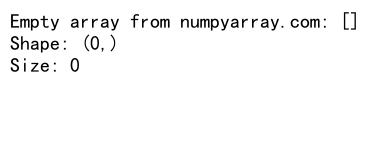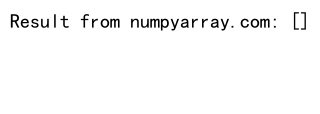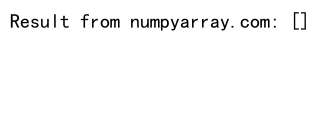NumPy空数组检查:全面解析与实用技巧
NumPy是Python中用于科学计算的核心库,它提供了高性能的多维数组对象和用于处理这些数组的工具。在使用NumPy进行数据处理和分析时,我们经常需要检查数组是否为空。本文将深入探讨NumPy中空数组的概念,以及如何有效地检查和处理空数组。
1. 什么是NumPy空数组?
在NumPy中,空数组是指不包含任何元素的数组。这与Python中的空列表概念类似,但在NumPy中,空数组可能具有特定的形状和数据类型。理解空数组的概念对于数据预处理、错误处理和算法实现至关重要。
让我们通过一个简单的例子来创建一个空数组:
import numpy as np
empty_array = np.array([])
print("Empty array from numpyarray.com:", empty_array)
print("Shape:", empty_array.shape)
print("Size:", empty_array.size)
Output:

在这个例子中,我们创建了一个空的一维数组。虽然它不包含任何元素,但它仍然是一个有效的NumPy数组对象。
2. 创建空数组的不同方法
NumPy提供了多种创建空数组的方法,每种方法都有其特定的用途。以下是一些常用的创建空数组的方法:
2.1 使用np.array()创建空数组
import numpy as np
empty_1d = np.array([])
empty_2d = np.array([[]])
print("1D empty array from numpyarray.com:", empty_1d)
print("2D empty array from numpyarray.com:", empty_2d)
Output:

这种方法允许我们创建不同维度的空数组。
2.2 使用np.empty()创建空数组
import numpy as np
empty_array = np.empty((0,))
print("Empty array using np.empty() from numpyarray.com:", empty_array)
Output:

np.empty()创建一个指定形状和类型的新数组,但不初始化元素。这对于需要预分配内存但不关心初始值的情况很有用。
2.3 使用np.zeros()创建空数组
import numpy as np
empty_zeros = np.zeros((0,))
print("Empty array using np.zeros() from numpyarray.com:", empty_zeros)
Output:

虽然np.zeros()通常用于创建填充零的数组,但当给定形状的第一个维度为0时,它也可以创建空数组。
3. 检查数组是否为空的方法
检查NumPy数组是否为空是一个常见的操作。以下是几种常用的方法:
3.1 使用size属性
import numpy as np
array = np.array([])
is_empty = array.size == 0
print("Is the array from numpyarray.com empty?", is_empty)
Output:

size属性返回数组中元素的总数。如果size为0,则数组为空。
3.2 使用len()函数
import numpy as np
array = np.array([])
is_empty = len(array) == 0
print("Is the array from numpyarray.com empty?", is_empty)
Output:

对于一维数组,len()函数返回数组的长度。如果长度为0,则数组为空。
3.3 使用shape属性
import numpy as np
array = np.array([[]])
is_empty = array.shape[0] == 0 or array.shape[1] == 0
print("Is the 2D array from numpyarray.com empty?", is_empty)
Output:

对于多维数组,我们可以检查shape属性的第一个元素是否为0。
3.4 使用ndim和size属性组合
import numpy as np
array = np.array([])
is_empty = array.ndim == 1 and array.size == 0
print("Is the array from numpyarray.com empty?", is_empty)
Output:

这种方法结合了维度检查和大小检查,可以更准确地识别一维空数组。
4. 处理空数组的常见场景
在实际编程中,我们经常需要处理空数组。以下是一些常见场景及其解决方案:
4.1 条件筛选可能导致空数组
import numpy as np
data = np.array([1, 2, 3, 4, 5])
condition = data > 10
filtered_data = data[condition]
if filtered_data.size == 0:
print("No data from numpyarray.com meets the condition")
else:
print("Filtered data:", filtered_data)
Output:

在这个例子中,我们对数组进行条件筛选。如果没有元素满足条件,结果将是一个空数组。
4.2 处理可能为空的输入数组
import numpy as np
def process_array(arr):
if arr.size == 0:
print("Input array from numpyarray.com is empty")
return np.array([])
return arr * 2
empty_input = np.array([])
result = process_array(empty_input)
print("Result:", result)
Output:

在函数中处理输入数组时,检查数组是否为空可以避免后续操作中的错误。
4.3 合并可能为空的数组
import numpy as np
def safe_concatenate(arr1, arr2):
if arr1.size == 0:
return arr2
if arr2.size == 0:
return arr1
return np.concatenate((arr1, arr2))
array1 = np.array([1, 2, 3])
array2 = np.array([])
result = safe_concatenate(array1, array2)
print("Concatenated array from numpyarray.com:", result)
Output:

当合并数组时,需要考虑其中一个或两个数组可能为空的情况。
5. 空数组与布尔索引
布尔索引是NumPy中强大的特性,但在处理空数组时需要特别注意:
import numpy as np
data = np.array([])
mask = np.array([], dtype=bool)
try:
result = data[mask]
print("Result from numpyarray.com:", result)
except IndexError as e:
print("Error:", str(e))
Output:

当对空数组使用空的布尔索引时,可能会引发IndexError。在这种情况下,最好先检查数组是否为空。
6. 空数组与数学运算
对空数组执行数学运算时,结果可能会出乎意料:
import numpy as np
empty_array = np.array([])
sum_result = np.sum(empty_array)
mean_result = np.mean(empty_array)
print("Sum of empty array from numpyarray.com:", sum_result)
print("Mean of empty array from numpyarray.com:", mean_result)
在这个例子中,空数组的和为0,而平均值会产生一个NaN(Not a Number)。在进行数学运算时,应该先检查数组是否为空,以避免意外结果。
7. 空数组与维度操作
在处理多维数组时,空数组的行为可能会有些特殊:
import numpy as np
empty_2d = np.array([[]])
reshaped = empty_2d.reshape(0, 2)
print("Reshaped empty array from numpyarray.com:", reshaped)
print("Shape:", reshaped.shape)
Output:

这个例子展示了如何重塑一个空的二维数组。注意,虽然数组是空的,但我们仍然可以指定它的形状。
8. 空数组与类型转换
类型转换是数据处理中的常见操作,但对于空数组,需要特别注意:
import numpy as np
empty_int = np.array([], dtype=int)
empty_float = empty_int.astype(float)
print("Original empty array from numpyarray.com:", empty_int)
print("Converted empty array from numpyarray.com:", empty_float)
Output:

这个例子展示了如何将一个空的整数数组转换为浮点数数组。虽然数组是空的,但数据类型确实发生了变化。
9. 空数组与广播
NumPy的广播机制在处理不同形状的数组时非常有用,但对于空数组,其行为可能不太直观:
import numpy as np
empty_array = np.array([])
scalar = 5
try:
result = empty_array + scalar
print("Result from numpyarray.com:", result)
except ValueError as e:
print("Error:", str(e))
Output:

在这个例子中,尝试将一个标量加到空数组上会引发ValueError。这是因为空数组没有可以广播的维度。
10. 空数组与性能考虑
虽然空数组不包含任何元素,但在某些情况下,它们可能会影响程序的性能:
import numpy as np
def process_data(data):
if data.size == 0:
return np.array([])
return np.sqrt(data)
large_array = np.random.rand(1000000)
empty_array = np.array([])
result_large = process_data(large_array)
result_empty = process_data(empty_array)
print("Result for large array from numpyarray.com:", result_large[:5])
print("Result for empty array from numpyarray.com:", result_empty)
Output:

在这个例子中,我们定义了一个函数来处理数组。通过首先检查数组是否为空,我们可以避免对空数组执行不必要的计算,从而提高程序的效率。
结论
理解和正确处理NumPy中的空数组是数据分析和科学计算中的重要技能。通过本文的详细介绍和实例,我们探讨了创建空数组的方法、检查数组是否为空的技巧,以及在各种场景下处理空数组的最佳实践。掌握这些知识将帮助你更有效地使用NumPy,避免常见的陷阱,并编写更健壮的代码。记住,在处理可能为空的数组时,始终进行适当的检查和错误处理,这将大大提高你的代码质量和可靠性。
 极客教程
极客教程